
  As a guitarist, nothing is more polarizing in some circles than your choice of "Axe", whether that be a pointy 80's aggressiveness of a B.C. Rich Warlock or the 60's Mod Coolness of a Vox Teardrop. But the truth is, a guitar is just a guitar, and it can be used on any genre you choose, and very often, that's how new styles of music, or new genres and genre variants are made. Nobody ever got anywhere in this industry, with any renown at least, without having SOME originality somewhere, even if it's something as rinky dink as what guitar they choose to stick around your neck.
As a guitarist, nothing is more polarizing in some circles than your choice of "Axe", whether that be a pointy 80's aggressiveness of a B.C. Rich Warlock or the 60's Mod Coolness of a Vox Teardrop. But the truth is, a guitar is just a guitar, and it can be used on any genre you choose, and very often, that's how new styles of music, or new genres and genre variants are made. Nobody ever got anywhere in this industry, with any renown at least, without having SOME originality somewhere, even if it's something as rinky dink as what guitar they choose to stick around your neck.
So what is an "offset" - it's a style of guitar body introduced by Leo Fender for Fender Musical Instrument Corporation in 1958 for the Jazzmaster and Jazz Bass products, both instruments designed for the Jazz market. The Jazz Bass holds the distinction of being the only "offset" that actually survived the 60's, 70's, and 80's without any discontinuation for any significant period. The Jazzmaster and Jaguar became surf-darlings, then faded off into the lands of Post-Punk and later Alternative. The Mustang became one of the primary poster-children of gRunge with the Jaguar, and almost all of these guitars got some now rather well out-dated views put upon them by the people who played them.
Now, enter the "misfit guitarist" - this is me - the guy who decided he liked the look of Cobain's Jaguar and had an appreciation for Grunge's punk DIY Roots and liked the very down-to-earth focus, but liked the wild and bombastic playing style of people like George Lynch, Edward Van-Halen, or Dimebag Darrell in the end....whaddaya' do then? Well, I could have just settled for playing only Kramers - which I Also do, or I could limit myself and continue playing grunge rock in it's gate-kept confines of "no solos/minimal solos" "no technical skill" and "no theory"...but that to me seemed boring. I decided rather than follow whatever "crowd", I'd just do my own thing, and if that pissed people off, great, I'm doing something right then. However, that made being social with other guitarists, tremendously difficult to say the least (though my mild high-functioning and undiagnosed ASD probably doesn't help either).
So here it is, all the research, data dumping, knowledge, whatever you call it, that I accumulated as I have continued to tweak and tune Jaguars, Jazzmasters, and Stang-type guitars beyond anything Leo probably knew they could do. The knowledge ranges from basic history and setting up a bone-stock instrument to perform on a level that makes them formidable in more demanding genres, without breaking your wallet. There's no "just throw in a Mastery/Descendant/Halon" here - this is nitty, gritty, old-school, DIY level tweaking, tuning, and modding, and I'm goign to express the logic, reason, and the science behind what I do. I'm going to go into things as crazy as cutting tremolo pivot pots and whammy bars, creating knife edges so sharp your pivot plate could function as a cheese slicer (and somehow make an offset "Cricket" like Brad Gillis at the "Were Stars" benefit). Some of it is modified advice from other folks like Puisheen or the Ventures, while others is just me tweaking and tuning these underrated monsters for years and being quite happy with them.
THE VARIOUS MAKES/MODELS

| Why? (Offset Shred) - Why I'm writing this page, my history (I've been focused on this since I got my first offset in 2000 - a Jag-Stang), what my goals are, and what I USE these musically for personally. I've been apparently a "pariah" on the offset-scene for the last 20 years, and never knew it. Since I don't really fit the stereotype, and adopted characteristics from my own favorite genres to choose to do my own thing. I'm basically a cross between a 80's hair metal shredder, 80's new wave/post-punk guy, and a 90's alt-rocker - without pandering to any of the three with any seriousness. Those are INFLUENCES, not laws or guidelines for me. But alas, being someone who plays Ratt, Whitesnake, Van-Halen, Night Ranger, or Loverboy on a Jag-Stang is somehow committing some kind of crime apparently - but not by my book. So I decided to reduce my presense here, since I never fit in with the pretentious Millennial crap anyway. So if you are wondering about whose writing this, why, and whatere I kinda' come from - here it is.
|
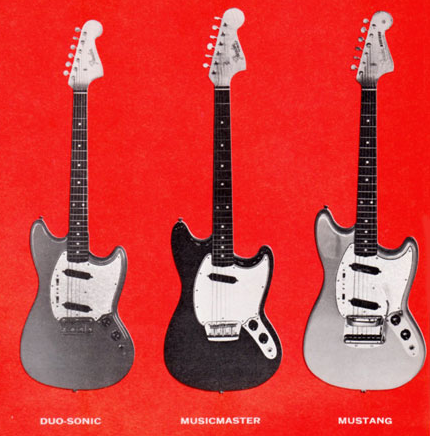
| Fender Student Models - In 1956, looking to placate to the beginner guitar market, Fender started to market two "Student Models" - the Duo-Sonic and Musicmaster. These models were originally NOT offset, but eventually adopted the waist design in 1964 when Fender introduced their new student model with a car-derived name and a whammy system - the famous Fender Mustang! The Fender Mustang would not be the last student model though, with Fender introducing bass-versions of all but the Duo-Sonic, a very MEtal-esque bodied guitar in the 22.5" short-scale known as the "Arrow/Swinger/Musiclander" - and another single pickup model known as the "Bronco", another Ford vehicle type name, with it's own unique vibrato system. These guitars would follow a similar path as the Jaguar and Jazzmaster, going to NEw Wave, Indie, Post-Punk, and Alt-rock circles, with a separate Trajectory in Japan due to a fellow named "Char" playing one that kept the Mustang Relevant all through the 1970's and 1980's (including a special run in 1984). Kurt Cobain of course, would make the Mustang popular in America again in the early 1990's, and since then, it's transcended it's student status as a pro-grade guitar.
|

| Fender Jazzmaster (and clones) - In 1958, Fender introduced the Jazzmaster guitar. Aimed at Jazz Musicians to compete with the likes of Gibson's Jazz guitars like the ES-series, the Jazzmaster failed at it's mission but succeeded in another one - SURF! Especially Surf instrumental music. While the "British Invasion" of the 1960's wiped out the Jazzmaster's popularity somewhat, some of the "legends" like Pete Townshend, Eric Clapton, and Jimi Hendrix - DID use Jazzmasters occasionally, likely contributing to them being less as ignored compared to others on this page. After a post-punk/new wave blub in the late 70's/early 1980's, the Jazzmaster found a home in the alt-rock circles of the early 1990's, and managed to pretty much stay relevant ever since, eventually becoming the Indie/Hipster stereotypical guitar. However, the Jazzmaster is one of the best aclimated vintage-style Fenders for hard-rock/metal music. This entire page explores the Jazzmaster product line (and clones) as a whole, finally getting collected in one easy to read place.
|

| Fender VI (Six) - In 1961, Fender introduced a new "Deluxe Bass" with a short 30-inch scale, six strings tuned 1 octave below a standard guitar, and regular guitar-style pickups called the Fender Six - for "Fender Six String Bass". While marketed as a Bass guitar, the VI is actually more of a strange in-between hybrid, not a Baritone, not a regular Guitar, and sometimes considered not fully a Bass due to the lighter string gauges used on the VI, and the wearker amplifiers of the time (per John Entwhistle of The Who) unable to generate enough bass frequencies to keep up with the band. The VI has a very limited number of famous players, and only 800 of the original 1961-1975 run of VIs were made - making them extremely rare. Probably the best known uses being by Joe Perry in Aerosmith for "Back in the Saddle" - already giving the VI a hard-rock pedigree to begin with, and The Cure's Robert Smith being probably the most well known, using it in Post-Punk rock music from about 1983 onward. To me, personally, the Bass VI Is a real freakin' workhorse, being able to emulate just about any bass guitar on the market, while being able to chug and "djent" with a clarity no EMG Equipped 7-string could pull off, with more low-range, and being able to be it's entirely own thing in the same vein as Robert Smith of The Cure's compositions. In more recent years, Fender has re-released the VI in a couple different price-points and it's found an interesting, decentralized home all across the art of playing music ever since.
|
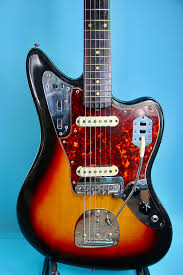
| Fender Jaguar (and clones) - In 1962, Fender released the Jaguar guitar. Likely the first time Fender introduced an actual new model name that's just a upgraded version of a previous model (the Jazzmaster). The Jaguar was designed as a less-as-genre-tied competitor to Gibson's guitars by shortening the scale to 24", introducing hotter-wound pickups in the more traditional Fender vein but with some additions to spread out the magnetic field, a flip-up mute as a last minute "gimmick" (a bit strong of a word but that's what others say), and individual toggle switches. The Jaguar had a bit of a mild career in the 1960's and 1970's, only finding a handful of places in the arms of New Wave and Post-Punk musicians back int he late 70's/early 80's after it's discontinuation in 1975 due to poor sales. The Jaguar would not really stick until it was popularized by Nirvana frontman Kurt Cobain's usage of a highly customized example with supposedly a studio musician pedigree from it's New Wave days (Martin Jenner). The Jaguar has since become a curiosity and a major breadwinner for Fender - with it, along side the Mustang and Jazzmaster, almost displacing or joining (depending on your point of view) Fenders Telecaster and Stratocaster as a premier model in their product line instead of a "Specialty" product.
|
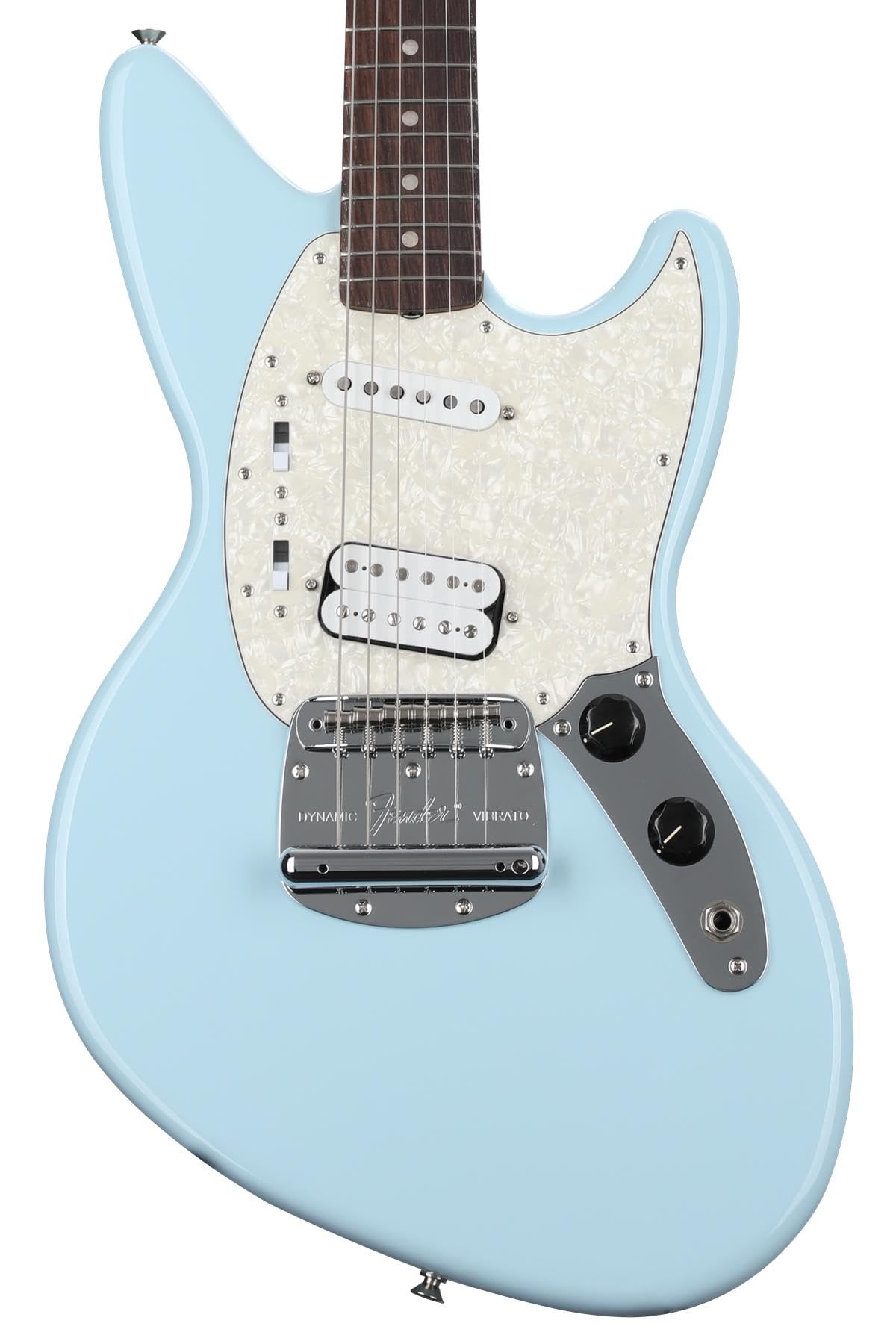
| Fender Jag-Stang (and clones) - In 1993, the Fender Custom Shop's Larry Brooks worked with Nirvana Frontman to create a unique signature model guitar. The result of 2 photograhs of a Jaguar and a Mustang put together resulted in what Kurt Cobain named the "Jag-Stang". The Jag-Stang toured pretty well with Nirvana through the southeastern and European legs of their "In Utero" tour in 1993-1994. About a year after Kurt Cobain passed away in 1994 (just as Fender was to ship out the second Fiesta Red prototype to him), Fender released a Fujigen Gakki built Japanese version of Kurt's custom shop guitar under the same name. The Jag-Stang would be much maligned for it's "funky" body design by people into aesthetics, and while yes, I could have just included this in the Student section easily, I feel it deserves it's own page as I feel the need to defend this model a bit. Featuring weaker pickups than Kurt's Guitar and a regular Mustang vibrato with Bridge (a Patent-related limitation), the Jag-Stang would come in and out of fashion over the next many years, facilitating multiple Japanese runs and a new run in Mexico starting on the 30th anniversary of the album Nevermind in 2021. The Jag-STang is where we start to see guitars on this page that are pretty well equipped for hard-rock/metal music in a more traditional sense, and IMHO the Jag-Stang frickin' SLAYS at heavy music.
|
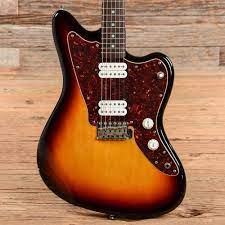
| Squier Jagmaster (and others) - In 1996, Fender introduced their JApanese built "Vista Series" guitar which included a new single hum version of the Musicmaster, the Venus (Courtney Love's signature model - aka Kurt's wife), the backwards-offset Jaguar-derived "Super Sonic", and this, the Jagmaster. This was representing the future of Fender's releases of various "Simplified" versions of their offset waist designs aimed at "Alternative Rock" musicians due to the mass popularity of offsets from bands like Nirvana, Tad, Mudhoney, Soundgarden, Sonic Youth, Smashing Pumpkins, My Bloody Valentine, and so on. Here while I'm going to focus on the Jagmaster, the Super-Sonic is also included because it's the same feature set as the original Jagmaster, but with a different body shape.
|
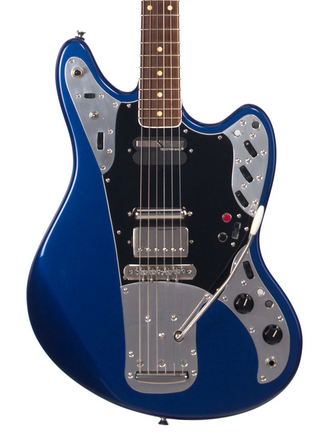
| Botique & Other Offsets - By the late 2000's, offset guitars started to catch on on a more mainstream level due to indie/hipster rock using them a lot. As a result, a lot of us industrious fans of the guitars started making our own versions of them. These included Bilt, Fano, TYM, and many others making custom, "botique" offset guitars aimed at fans of the ones mentioned above. Since then, many mainstream major makers such as G&L and Suhr have gone on to start making offset designs of their own aimed at all price ranges from the Guitar Fetish models to the highest high end Suhr models aimed at studio musicians - cementing offset guitars as a mainstream choice in all forms of music. HEre, we will also explore some of the more specialty offset models such as the Electric XII/Maverick/Custom, and even discuss Offsets that are not of the usual variety (like the Fender Prodigy - an Offset Superstrat).
|
TECH ARTICLES
Offset Guitars are a little more special than other "Standard" designs like I talk about on the gear page, and I have ways of making them bulletproof without losing the unique character of these vibrato systems, pickups, and electronics, while expanding them further. This is honestly what I got known for on various internet forums in the 2000's (particulary my Jag-Stang setup guide on Jag-stang.com). This is my place to preserve these articles, and update them without having to go on a ramapant search.

| How I Setup my *Stangs for Heavy Whammy Use - The article that started it all for me, I talk about how to setup your Fender Mustang/Jag-Stang/Custom/Maurauder-clone/Fresher Mercury....anything with that whammy pretty much, to hold up along side a Floyd Rose like a beast. I'm also expanding it to discuss variations in this design, parts interchangability, benefits, and how the system actually works (Finally), because I feel the tech behind it is totally misunderstood by the guitar community by large (it works VERY Different than most fulcrum-based vibrato units).
|
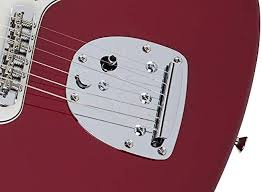
| How I Setup my Floating Trems for Heavy Whammy Use - The version I have created regarding the Jaguar and Jazzmaster floating tremolo. This one gets a little more complicated because of the Bass VI being a bit of a different "use case" from the Jaguar and Jazzmaster (and similar guitars). Just like above, we discuss how this vibrato system works, what it does, and some of the unique characteristics that make this vibrato system a really cool addition to your aresenel of guitars with some really unique exploits/features that can create some pretty cool sounds.
|

| Attempting to De-Mystify the Bronco Trem w/o Owning One - One of the rarest, weirdest, Fender vibrato units ever made. IN 1967, Fender introducted the Bronco guitar, and it featured a unique new trem system only ever used on that model only. I can at least expound on the functionality, it's potential, and it's potential flaws. Maybe someday I'll get to try one, but there's a lot of things I can gather about these. This is also a good introduction as to how I think as an offset player and fan before I procure such an instrument to try out.
|

| Student Model Wiring & Mods Explained - De-mystifying the functionality, tricks, and mods behind Fender's Duo-Sonic II, Mustang, and Jag-Stang models, and explaining ways to make the circuit more useful, or leveraging those two little slide switches for better functionality or more functionality. It's pretty amazing what one can do with a guitar with 2 DP3T on/on/on slide switches. We even talk about advanced things like extreme treble bypass, active pickups (EMGs !!!), and non-destructive ways of carrying out these mods on a guitar so you can preserve it's original routing and wiring (My Jag-stang's body is 100% bone stock - no non-factory routing in it BTW).
|

| The Wiring of the Fender Jaguar and Jazzmaster - Explaining the ideas behind Freddie Tavares' Dual Circuit Design, clever tricks, and the caveats, issues, tricks, and trials of installing things like active pickups, sustainers, and other additional wiring mods into an Offset guitar utilizing this specific type of circuit design. Due to the mass number of switches, and the places to put them, the Jaguar and Jazzmaster design itself lends well to a lot of cool user-options, some of which are almost modular (ie installing a Fuzz or other Effect into the Rhythm Circuit cavity, isolating your Sustainiac to a DPDT switch, ideas using a FreeWay selector switch, all kinds of wild stuff) - all the while honoring Leo and Freddie's original design and sometimes even implimenting it INTO The pre-existing design.
|
|

